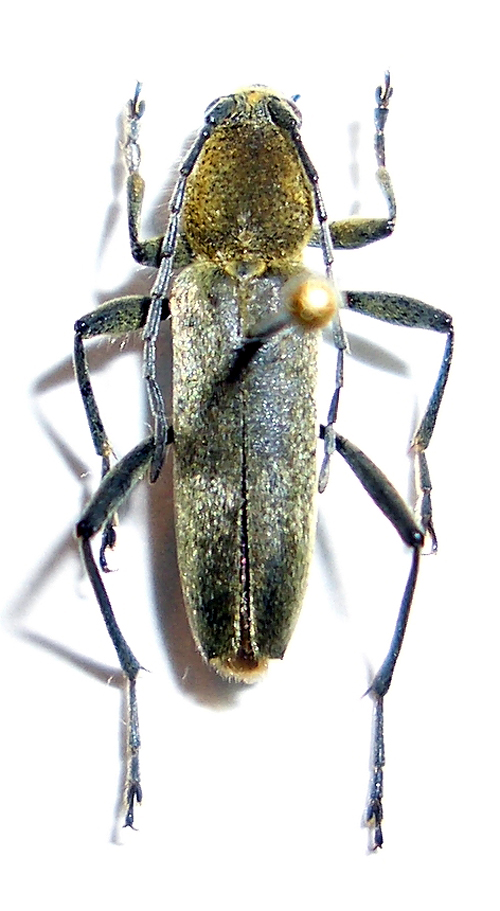| Author |
 Topic Topic  |
|
|
Sergi
Member Rosenbergia
   
Spain
1748 Posts |
 Posted - 17/12/2017 : 12:52:54 Posted - 17/12/2017 : 12:52:54



|

234.65 KB
From China, Yunnan reg. Size: 10mm
Chlorophorus sp. |
Edited by - Xavier on 17/12/2017 13:31:07 |
|
|
Xavier
Scientific Collaborator
    
France
12338 Posts |
 Posted - 17/12/2017 : 13:30:00 Posted - 17/12/2017 : 13:30:00



|
It is one, or another, species of this list (and may be more):
Chlorophorus eleodes (Fairmaire, 1889) Chine (sud)
Chlorophorus gaudens Holzschuh, 1992 (Sichuan)
Chlorophorus intactus Holzschuh, 1992 (Yunnan)
Chlorophorus kabateki Holzschuh, 1998 (Sichuan)
Chlorophorus praecanus Holzschuh, 2006 (Yunnan)
Chlorophorus salicicola Holzschuh, 1993 (Yunnan)
Chlorophorus trivialis Holzschuh, 2010 (Yunnan)
Chlorophorus viridulus Kano, 1933 Taiwan
All those species are yellowish - grey, without disctint spots. Holzschuh, who described almost 6 of them, didn't provided any key. His pictures are generally insufficient to understand differences with the first one (Faimaire, 1889). Holzschuh can add 20 more yellowish species, without any rebuttal : nobody can check if his species are true or not. |
 |
|
|
Sergi
Member Rosenbergia
   
Spain
1748 Posts |
 Posted - 17/12/2017 : 15:15:11 Posted - 17/12/2017 : 15:15:11



|
| Yes Xavier, Holzschuh never provided any key... in the future, people will see more synonymies with Holzschuh species... |
 |
|
|
Xaurus
Member Rosenbergia
   
Germany
1965 Posts |
 Posted - 18/12/2017 : 02:07:20 Posted - 18/12/2017 : 02:07:20



|
| Again: in this highly complex groups you need a lot experience, without study of the male genitals you have now chance to get a sufficient ID, later if you know the species well, often it's easy to differentiate very similar species, look f.e. to Chlorophorus annularis and annularoides both are very similar in pattern and outer morphology but the male genitals are quite different; furthermore, the range of species variation in Clytini is complex too, in many species the variations are negligible, and between them there are species with a wide range of variation, so it's almost impossible to separate the species maybe by dots or lines etc.. first. |
 |
|
|
Xavier
Scientific Collaborator
    
France
12338 Posts |
 Posted - 18/12/2017 : 09:08:04 Posted - 18/12/2017 : 09:08:04



|
Yeah, but I'm not saying it isn't. Holzschuh does not give any keys to separate his species nor he presents the edeages of all these species. Holzschuh's species are like a black box, for everybody !
But I'm the only one who dares to say that, so I must be wrong.  |
Edited by - Xavier on 18/12/2017 09:16:39 |
 |
|
|
Francesco
Forum Admin
    
Luxembourg
9515 Posts |
 Posted - 18/12/2017 : 11:31:07 Posted - 18/12/2017 : 11:31:07




|
Xavier, you are not the only one: here I expressed my perplexities about another taxon.
But now, Breuning is the big building site... we have time for more modern taxonomists...  |
 |
|
|
Xaurus
Member Rosenbergia
   
Germany
1965 Posts |
 Posted - 19/12/2017 : 01:42:40 Posted - 19/12/2017 : 01:42:40



|
You are completely right Xavier, many of this species are a black box for me too, with the descriptions its really difficult or impossible to ID most of this species, and the genitals are given only for a part, almost not for the older ones, which are used for comparisons  . .
What I mean, you can study the genitalis of your Clytini for a better separation of each species first, and maybe later its more easy to find a name. |
 |
|
|
Xavier
Scientific Collaborator
    
France
12338 Posts |
 Posted - 19/12/2017 : 10:09:49 Posted - 19/12/2017 : 10:09:49



|
quote:
Originally posted by Xaurus
What I mean, you can study the genitalis of your Clytini for a better separation of each species first, and maybe later its more easy to find a name.
Yes, it is the only thing to do, and Francesco told me the same ! |
 |
|
| |
 Topic Topic  |
|


